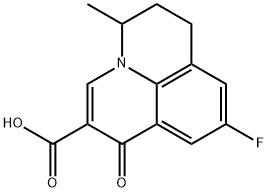| Animal-specific antibacterial drugs |
It appears as white powder and is odorless and tasteless. It is insoluble in water but is immiscible with organic solvent.
Flumequine is a kind of synthetic second-generation, animal-specific quinolone antibacterial drugs. It is currently the only non-humans shared broad-spectrum antimicrobial veterinary drug. It is taken as the substitute product of norfloxacin. It has a strong bactericidal activity with excellent efficacy in the treatment of animal bacterial diseases. Its main effect is to inhibit bacterial deoxy nucleic acid (DNA) gyrase, interfering with the deoxyribonucleic acid (DNA) synthesis, thereby causing failure of cell for further division, and thus playing the role of killing bacteria. It is mainly used in animal bacterial respiratory disease including E. coli, dysentery, salmonellosis, typhoid, fowl cholera, staphylococcal disease and infectious rhinitis. It can also be used for the treatment of E. coli disease, monospora disease and Vibrio disease in aquatic animals with strong inhibitory effect on the Aeromonas hydrophila.
Flumequine was first successfully developed by the Rinker laboratory and had been successively and widely used in the EU and Japan and other countries in livestock and aquaculture since 1970s with excellent efficacy in the treatment of various kinds of diseases caused by Gram-negative infections, especially for the treatment of livestock, poultry and aquatic animal diseases caused by Escherichia coli, mycoplasma, and Aeromonas hydrophila. It had been gradually developed and approved to enter into market by our country in the late 1990s and mainly used for the control of bacterial infection diseases of salmon, trout, shrimp, eel and pigs as well as chickens.
Since quinolones-class sodium flumequine can inhibit bacterial DNA gyrase and has a broad spectrum antibiotic, high efficiency, low toxicity and strong tissue penetration capability with no anesthesia effect, it has become one of the most important anti-infective drugs in veterinary clinical diagnosis and aquaculture and has been used extensively for the treatment, prevention and promoting growth. Because of its resistance and potential carcinogenicity, the European Union, Japan and China have all provided their maximal residue limit in the tissue (our country and the European Union both use the value of 100ppb). The current methods of detecting flumequine mainly include fluorescent spectrophotometry, enzyme-linked assay (ELISA) and liquid chromatography. ELISA, with its high sensitivity and easy operation, has become routine screening methods.
This information is edited by Xiongfeng Dai from Chemicalbook. |

 China
China







